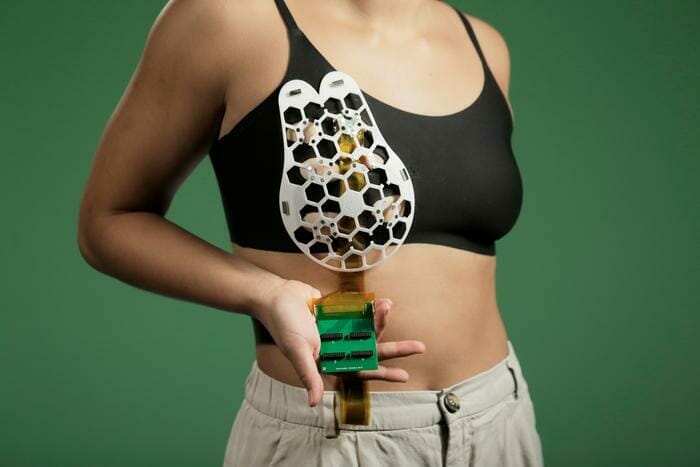A wearable ultrasound patch may be able to detect early breast tumors in patients at high risk of breast cancer, according to research published in Science Advances.1
This device, called the cUSBr-Patch, has only been tested in a single patient thus far but has comparable accuracy to ultrasound probes used in an imaging center, according to researchers.
The researchers created the cUSBr-Patch so that patients at high risk of breast cancer could monitor their breast tissue at home between regular mammograms.
“We changed the form factor of the ultrasound technology so that it can be used in your home. It’s portable and easy to use, and provides real-time, user-friendly monitoring of breast tissue,” study author Canan Dagdeviren, PhD, of Massachusetts Institute of Technology (MIT) in Cambridge, said in a statement.2
The cUSBr-Patch has 3 components: a soft fabric bra that serves as an intermediary layer, a honeycomb patch that serves as an outside layer to provide structure and guidance for a 1D ultrasound array, and a tracker attached to the ultrasound array for handling and rotation of the array.1
The researchers noted that the honeycomb patch has “open spaces for the tracker to move through as it traverses a specified path to allow for a maximal field of view.”
The researchers tested the cUSBr-Patch on a 71-year-old woman with a history of breast abnormalities. The device detected a 1 cm cyst in her left breast and a 0.3 cm cyst in her right breast.
The researchers cross-validated these results with an ultrasound specialist, whose results were the same as those found with the cUSBr-Patch.
Prior to cross-validation, the researchers checked the imaging performance stability of the patch over time. They found that the array could still detect the 1 cm cyst with similar image quality after 30 minutes with 15-minute intervals. This finding demonstrates “the repeatability of array positioning due to the honeycomb patch, a key capability to enable long-term monitoring,” the researchers wrote.
“This technology holds the promise of breaking down the many barriers for early breast cancer detection by providing a more reliable, comfortable, and less intimidating diagnostic,” study author Catherine Ricciardi, nurse director at MIT’s Center for Clinical and Translational Research said in a statement.2
“One of the main obstacles in imaging and early detection is the commute that the women have to make to an imaging center,” added study author Tolga Ozmen, MD, a breast cancer surgeon at Massachusetts General Hospital in Boston. “This conformable ultrasound patch is a highly promising technology, as it eliminates the need for women to travel to an imaging center.”
The researchers are planning additional studies of the cUSBr-Patch, including “intensive clinical trials with long-term imaging during the course of medical treatments.”1
Disclosures: This research was partly supported by 3M. Please see the original reference for a full list of disclosures.
References
1. Du W, Zhang L, Suh E, et al. Conformable ultrasound breast patch for deep tissue scanning and imaging. Sci Adv. Published online July 28, 2023. doi:10.1126/sciadv.adh5325
2. A wearable ultrasound scanner could detect breast cancer earlier. News release. EurekAlert. Published July 28, 2023. Accessed July 31, 2023.
This article originally appeared on Cancer Therapy Advisor
